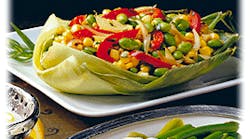Soy has been the symbol of health food for so many years it was inevitable the popular press would start taking potshots at it. Research suggesting a link between soy and breast cancer led to newspapers and news magazines splattering their pages with tofu gore as pundits contrived to make soy seem like the next version of the plague – or at least trans fat, unsafe in any amount.
About the same time as the breast cancer research the American Heart Assn. weighed in with questions about the benefits of soy in cholesterol reduction. The reservations were valid, and based on current research. Also, the position paper carrying the AHA’s statement included references to soy’s known benefits. Yet this, too, was showcased as a blanket dismissal of soy. I’m guessing we’re probably only a newsflash or two away from Center for Science in the Public Interest filing a lawsuit against – I don’t know, Mother Nature, perhaps? – to rid the world of this newfound food terror.
The breast cancer tumult centers around a recent study in which isoflavones from soy, fed during select stages of rat growth and development, did display a negative effect on estrogen-sensitive tumors that had been induced in the test animals. Also, amounts of isoflavones used in the rodent studies equate to diets that would be considered extremely high in soy in a human population.
As with the 9,000 or so other papers released on soy in the past 16 years, this is one facet of a phytochemical-rich food ingredient meant to stimulate more investigation into the ancient and widely used commodity.
The AHA paper also cast in doubt soy’s ability to protect against hot flashes during menopause and to help reduce postmenopausal bone loss. According to the Soyfoods Council (www.thesoyfoodscouncil.com), this position was “based on a limited review of studies in these areas.” As the council points out, there are more comprehensive studies published which have reached different conclusions. One such study is the Shanghai Women’s Health Study of 65,000 women. The study showed a number of benefits from soy to heart, bone and even breast cancer risk.
Mark Messina, Ph.D., one of the world’s leading experts on soy, notes, "The benefits of soy have been written about for years, so, from a journalistic point of view, any 'news' is going to be in the negative. Soy is not a miracle food and never was. It’s not medicine, but it’s still important and has a lot to offer."
Soy is a high-quality, highly bioavailable source of complete proteins. It’s loaded with calcium that’s absorbed as readily as that from dairy milk and its iron content was also determined to be readily available. It’s rich in vitamins and fiber, too. Would I recommend a relative or friend recovering from breast cancer eat soy? The honest answer is “only occasionally.”
Here’s what processors of soy foods and beverages need to know: The majority of the thousands of published studies on soy show it to be a valuable, reasonably healthful food ingredient.
Do I think soy is the next Killer Tomato? No, and anyone reporting so is engaging in that transgression of ethics known as “science by sound bite.”
